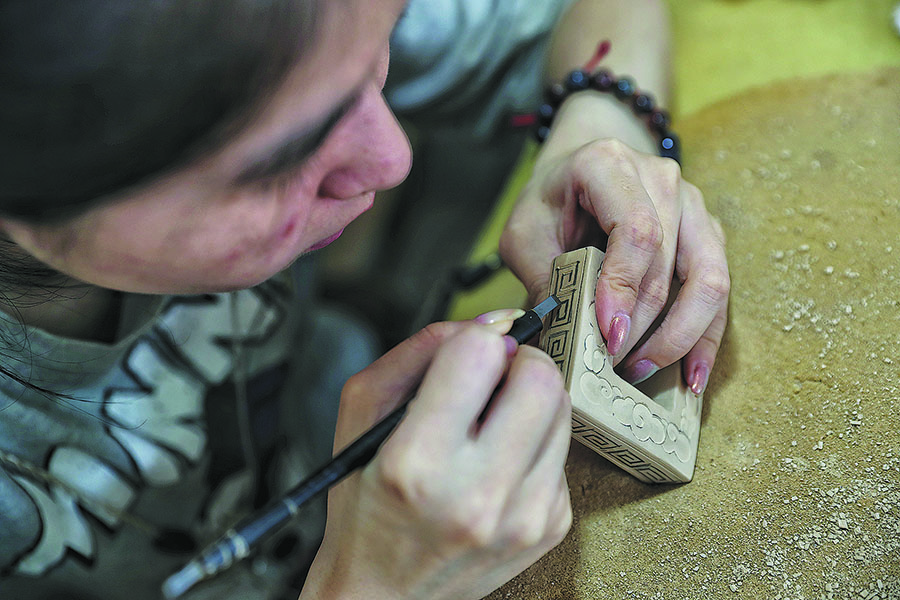Firing up the next generation

To produce Longquan celadon pottery, dozens of steps are needed before firing, such as carving patterns, sticking together different parts, glazing and making tiny adjustments. [Photo by Jiang Dong/China Daily]
Green attraction
Since the porcelain was produced in Longquan during the Three Kingdoms period (220-280), it has been widely used, becoming a household staple across the nation and also adored by royal families both at home and abroad.
Within the city of Longquan, more than 500 sites that used to be kiln clusters were discovered by archaeologists, a telling testimony of the prosperity of Longquan's celadon-glazed pottery industry.
The production of Longquan celadon reached its peak during the Southern Song Dynasty (1127-1279). Many thousands of porcelain items bearing the famous green glaze were shipped to Southeast Asia, Europe and East Africa.
The name, celadon, is derived from a French novel L' Astree. The name of the story's protagonist is the shepherd Celadon, who wears a green cloak. His look became chic in 17th century Paris. At the time, the Longquan porcelain, which shared a similar color to the fictional hero's cloak, was popular among the upper class in France.
"The simple shape and jade-like color of the porcelain is a vivid demonstration of Chinese culture and aesthetics," says Liu Ying, director of the Celadon Museum in Longquan.
Celadon is like Chinese people's personality — it's subtle, gentle, quiet and reserved. Because of its color and glossy finish, it's also called "artificial jade", reflecting people's love of the precious stone, which bears the virtues that Chinese people pursue and cherish still, says Liu.
"Celadon is also a color from nature. In traditional culture, Chinese people always promote a harmonious way to coexist with nature," adds Liu.
In the eyes of budding craftsman Yang Leping, all things related to celadon pottery are about nature. The 72 processes needed to produce Longquan celadon-glazed pottery are all related to elements found in nature, including fire, wood, clay and water.
Yang says the name of two typical green varieties are also from nature. Lavender gray, or tianqing in Chinese, means the color of the sky after rain. The plum green, obviously, refers to the fruit, just as it's about to ripen.
The 27-year-old set up his own studio in 2016 to seek the exquisite beauty of green glaze. Every time he feels any doubt, he will go back to Dayao village in Longquan, his birthplace and now an archaeological park. It is the site where many millennium-old kilns were found.
"When I was a kid, I enjoyed collecting pieces of celadon pottery found at my family's farmland. My grandfather hoed the weed, and lots of fragments of the local porcelain would be unearthed. That was my early introduction of the different shades of green," says Yang.
Yang's inspiration all comes from nature. He loves to explore the mountains around the city of Longquan and walk along rivers and through the villages.
To get a perfect green glaze, Yang has to run the gauntlet of uncertainty throughout the 72 processes — a wrong temperature or bad weather could spell failure.
"I think the persistent pursuit of a perfect hue of green explains why Longquan celadon pottery has enjoyed centuries of popularity," Yang says.
Liu, the celadon pottery museum director, says that its charm lies in the spirit of craftsmanship that has continued for centuries.
